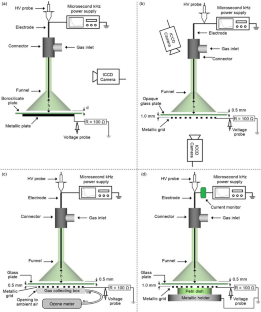Plasma Electrode Dielectric Barrier Discharge: Development, Characterization and Preliminary Assessment for Large Surface Decontamination
Abstract
The paper gives the detailed information about a newly developed plasma system applicable for conductive target non-thermal plasma indirect treatment. High voltage microsecond duration pulses delivered in the kHz range are used to ignite a discharge in a glass funnel vessel flushed with argon and equipped with a needle electrode. An air dielectric barrier discharge (DBD) can subsequently be generated if a grounded grid is set a few millimeters apart from the thin glass plate constituting the funnel base, in the funnel-DBD setup. Thus, this air DBD operates with its powered electrode consisting in the transient argon streamer discharge spreading inside the funnel and over the glass plate. This “plasma electrode DBD” is characterized using time-resolved ICCD imaging together with voltage and current probes. This work reports for the first time the funnel-DBD proof of concept operation and its potentialities for large surface decontamination. Argon and air plasma temporal and spatial development is documented and analyzed while electrical characterization using Lissajous plots provide key information on the power and capacitances of the funnel-DBD setup. It is reported that the funnel-DBD operates as a large surface and low power discharge. As with any air-DBD plasma, the modulation of the power density delivered across the air-DBD, processed with changing the pulse repetition rate, results in the control of the ozone concentration. Beyond the plasma electrode-DBD development and characterization, the main motivation of this work is the treatment of conductive samples with the perspective of large surface decontamination. Preliminary demonstrations of the bacterial and yeast inhibition are thus reported for in vitro cultivations through indirect treatment with the funnel-DBD delivering reactive nitrogen and oxygen species.


| 公司名称 | 产品信息 | 采购帮参考价格 |
|---|
 求助内容:
求助内容: 应助结果提醒方式:
应助结果提醒方式:


